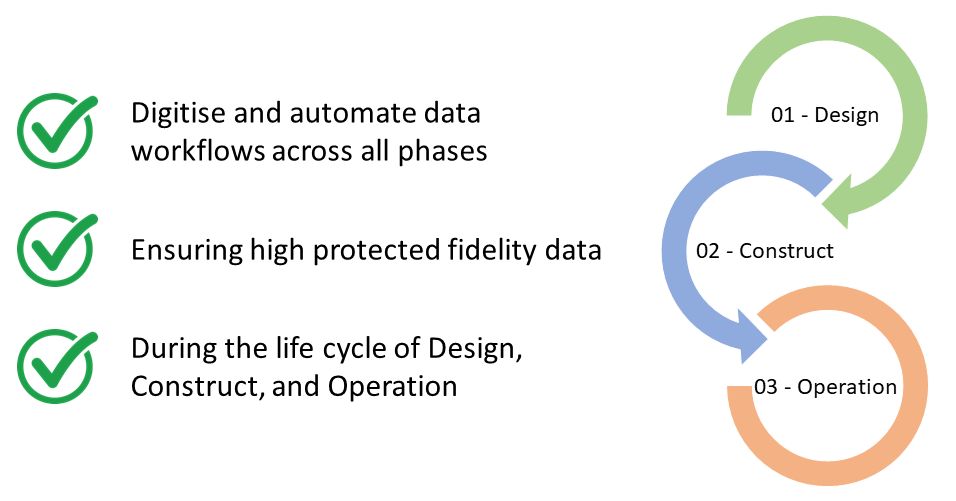AI-Powered BIM: Transforming the Construction Landscape!
This blog series will explore how the integration of Artificial Intelligence (AI) technology with Building Information Modelling (BIM) has revolutionised the construction industry by significantly transforming the BIM experience for clients!
In this series, we’ll cover:
- Automated Design Optimisation
- Data-driven Decision Analytics for Onsite Risk Mitigation
- Virtual Reality (VR) and Augmented Reality (AR) Visualisation

Automated Design Optimisation
AI-driven BIM goes beyond algorithms, with tools like Generative Design and Dynamo in Revit playing a crucial role. These tools analyse data using AI algorithms to generate intelligent design suggestions, making designs more efficient and sustainable. AI algorithms like Genetic Algorithms, FEA with Machine Learning, and Reinforcement Learning optimise design processes, empowering informed decision-making.
With data being a key element in AI, Pentagon ensures effective data management for opportunities in Design & Construction verification, Digital Twins, Asset Performance Management, and prepares for future AI advancements.

Using tools like Dynamo allows complex tasks to be simplified through a visual programming interface. Its node-based system allows architects and engineers to design algorithms visually, promoting collaboration and efficiency. The customisation and automation of Dynamo empowers users to create scripts that automate repetitive tasks, saving time and reducing errors in the design process. This capability streamlines workflows and enhances overall project efficiency.
Designers and engineers can leverage Dynamo scripts with factors such as the boundary line and height of the building being considered. The script subsequently computes the layout based on the specified model parameters. The tasks of the script are broken down into three well-defined steps: inputs, generators, and evaluators.
- Inputs – This stage involves identifying and defining the various parameters and data points needed for the script, ensuring a comprehensive understanding of the project’s requirements.
- Generators – In this step, the script generates or creates the necessary computations and processes based on the input parameters. It’s where the logic and operations are formulated.
- Evaluators – The evaluators examine and assess the generated results, ensuring that they align with the project’s goals and specifications. This step acts as a quality check, validating the accuracy of the calculated airflow.
By inputting these nodes and parameters at the specified stages, architects and engineers can precisely calculate the required layout and shape.
As we move over to Revit, our developed script seamlessly integrates with Revit’s generative design feature. It enables us to precisely define our study by handpicking the desired elements and configuring goals, constraints, and generation settings. Once satisfied with your configurations, all that’s left is to let the software generate your outcomes. Depending on the number of generations you’ve specified, you can cycle through each one and seamlessly incorporate the Revit element into your project.
Dynamo facilitates real-time simulation and performance testing of diverse building layout scenarios. Designers can dynamically adjust parameters and settings, observing their direct impact on model generation. This process not only streamlines decision-making but also enhances communication with clients and stakeholders, providing a clearer understanding of the design evolution. In the realm of building generation and massing, Dynamo plays a transformative role, reshaping our approach to architectural design.
To conclude, utilising AI-based tools and technologies can revolutionise the AEC industry by optimising designs for a more efficient and sustainable built environment. As technology advances, we anticipate even more innovative applications. Pentagon’s consultancy services can assist customers in optimising design workflows through generative design, analysis, customisation, and complete digital integration. If you want to gain efficiencies across all phases of your projects and plan for future challenges, reach out to our team.
Keep your eyes peeled for our second blog in this series where we’ll look at data-driven analytics for onsite risk mitigation!

Want to learn more about Dynamo and Revit?
Explore Pentagon’s Introduction to Dynamo for Revit 1-day training course or choose from over 10+ Revit courses covering a wide range of disciplines!
Browse our online training calendar: www.pentagonsolutions.com/training-events/
Or fill out the form below to request a free consultation with our Digital Construction Integration team:
Contact Us
"*" indicates required fields


